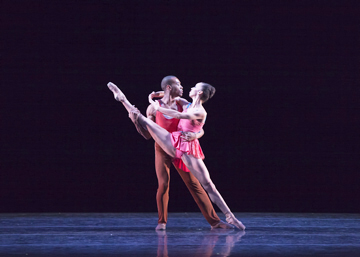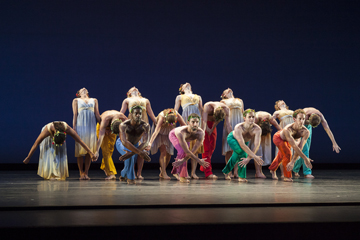Dance: DTH, Mark Morris, Paul Taylor, An American in Paris
By Dawn Lille
ART TIMES July 2015 online
 Chyrstyn Fentroy and Fredrick Davis in Vessels, Photo by Renata Pavam |
Three years ago Virginia Johnson, a former leading ballerina with Dance Theatre of Harlem (DTH), took over and restarted the company that had shut down due to poor financial management. DTH was created by Arthur Mitchell, the first full time black dancer with the New York City Ballet, and Karel Shook, a noted teacher, and gave its first performance in 1970. New York City Center had been home to the company and their April performances marked their first return to this venue.
This is a young troupe still working to develop a cohesive style and approach, which they are doing in part through their school. The program I saw, one of two, was called “What’s New” and had almost a full house that was supportive and vocal.
Dancing on The Front Porch of Heaven , choreographed by the late Ulysses Dove in 1993 to Arvo Part’s music, opened the program. Subtitled “Odes to Love and Loss,” it is a carefully structured piece for 6 beautifully rehearsed dancers clad in white unitards and featured in pools of light. It is an homage to life and set a thoughtful mood.
Darrell Grand Moultrie’s Vessels was made by a choreographer who looked at his performers, and choreographed, to some degree, according to their strong points. The result was a well crafted work in which the dancers crossed back and forth in absorbing patterns to music by Ezio Bosso, in what the program describes as a cyclic journey of Light, Belief, Love and Abundance. Moultrie made wonderful use of the entire company, showcasing the women in pointe shoes and the men bare footed.
The problem was that it followed Nacho Duarte’s Coming Together, a work full of gaudy sets and costumes. It also showed the dancers’ long legs and technique, but both were extroverted showpieces that should not have been programmed back to back.
Although the women wore pointe shoes in both dances, neither was a classical ballet. The one piece that was, Balanchine’s Tchaikovsky Pas de Deux, was cleanly danced, if a bit shaky in spots.
It will take this company more time to be strong in projecting its own style. With a troupe of only 18 they cannot perform the Giselle they did many years ago. But they are interested in using dance to engage and change the communities in which they perform. Judging by the audience reaction, they are doing so.
***
 Spring, Spring, Spring |
The Mark Morris Dance Group appeared at the Brooklyn Academy of Music in late April in two different programs. This company, with its idiosyncratic and brilliantly musical head, is always rewarding and often surprising. What attracted me to Program B was the desire to see Morris’ take on Stravinsky’s “Rite of Spring.” Since its debut in Paris in 1913, using Vaslav Nijinsky’s choreography, the music has been appropriated by dozens of choreographers, with results ranging from good to awful, and it keeps drawing in those who create dances.
Morris calls his version Spring, Spring, Spring and it is danced by 15 members of his 18 member company, to a score arranged by three musicians who call themselves The Bad Plus. A predominately jazz trio of piano, bass and drum, they have taken the music and deconstructed it, resulting in a vivid score.
Morris’ Sacre is a ritual, but a more joyful one of mating rather than sacrifice and death, supported by the musical arrangement, whereby Stravinsky’s rhythms become jazzy, not ominous. The work began in darkness, with the first strains of the music barely audible.
Looking at his use of lines and circles one suspects Morris might have studied the photos of Nijinsky’s choreography, but the result is very much his own. At one point the bare chested men in bright colored pants walked straight legged in a line across the stage, body facing one way and head in profile, recalling the women in Nijinsky’s ballet Afternoon of a Faun.
In another sequence three rows, one of six (3 men and 3 women), one of five (women) and one of four (men) moved downstage and then upstage in a shifting pattern of interchanging bodies. They could have been sowing seeds or representing different parts of an orchestra, the women, in v-necked, flowing dresses, presenting a softer vision.
All in all the stage was filled with uplifting, moving music. This spring was most welcome, proving it is possible to create a new present from the past.
***
Paul Taylor’s American Dance Company gave its first season at Lincoln Center under its new name. Taylor still created two new works and presented Doris Humphrey’s Passacaglia and Fugue to Bach’s music and Shen Wei’s Sacre to Stravinsky.
Throughout the season the company danced 21 Taylor works full out, often tearing up the stage. There was live music for every performance – the Orchestra of St. Luke’s, directed for these presentations by Donald York, the music director of the company. This added immeasurably to the season since York is one of those rare conductors who watches the performers and follows them.
One of the old Taylor pieces was Brandenburgs, to sections of Bach’s Concertos #6 and #3. The choreography for this work, created in 1988, invites the viewer to see Bach on stage and the result was marvelous.
Both new works, Death and the Damsel and Sea Lark, exhibited some of Taylor’s imbedded talents: the ability to infer the sinister in comparison to innocence in the former and a sense of silly playfulness in the latter. But neither felt like truly finished creations.
Doris Humphrey, one of our American modern dance pioneers, died in 1958, leaving a legacy of meticulously crafted works and a book on how to make dances. José Limón was her protégé, so it was only natural that the Limon Company danced the Passacaglia – carefully and with great authority. This piece, about mankind and its destiny, is somber and unparalleled for learning the craft of dance composition, but not exciting for today’s audiences.
The Shen Wei Sacre was performed by Shen Wei Dance Arts. It is lovely and floating, but nowhere as good as Taylor’s piece to the same music. One could question the choice of these works.
Last year, in reorganizing his company, Taylor indicated that he wished to be an incubator for emerging choreographers. Next season he will add works by Larry Keigwin, Lila York and Doug Elkins – all mid-life choreographers. See you same time next year.
***
An American in Paris, with music and lyrics by George and Ira Gershwin, a new book by Craig Lucas, and direction and choreography by Christopher Wheeldon is an evening of dance to incomparable music. There is little dialogue and no such thing as a song without dance in the entire show. I had qualms about an Englishman choreographing and directing (for the first time!) a Broadway production based on music with such strong jazz and blues undertones. Few who are not American are able to get this quintessentially American sense of rhythmic syncopation and inner sorrow that is built into our speech, our designs, our bodies.
Wheeldon, widely admired as a ballet choreographer, did an excellent job. Robert Fairchild, the New York City Ballet soloist in the lead, was wonderful in performing and sensing the body deviations that are the equivalent of the music.
Leanne Cope, the female lead and a member of the Royal Ballet of England, was beautiful but, at times, lacked that hovering inner jazz feel.
That said, the production is all about moving to that moveable music and, although the singing was fine and the dialogue crisp, the body told this story. Unlike so many musicals, there were only a few “big” numbers, “Stairway to Paradise” among them. I left the theater smiling.
dawnlille@aol.com
